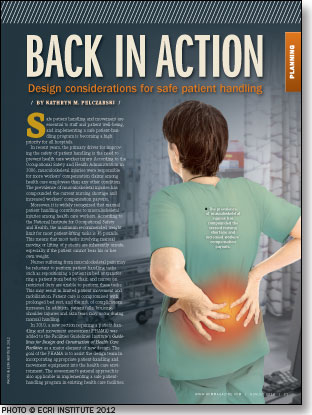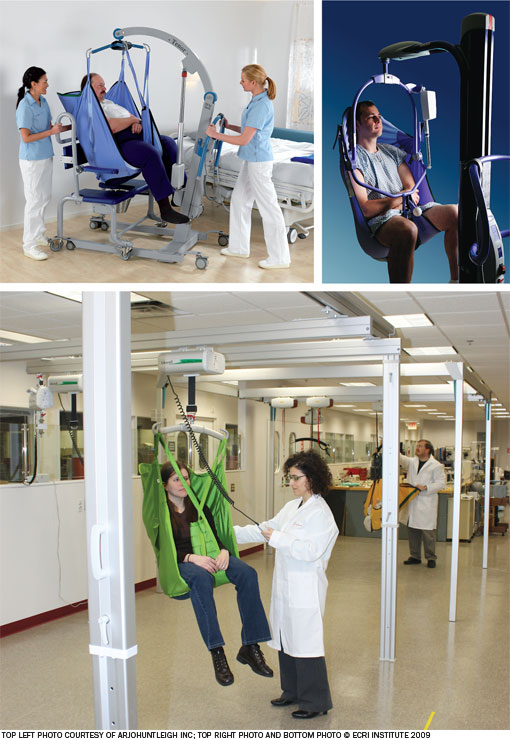 Safe patient handling and movement are essential to staff and patient well-being, and implementing a safe patient-handling program is becoming a high priority for all hospitals.
Safe patient handling and movement are essential to staff and patient well-being, and implementing a safe patient-handling program is becoming a high priority for all hospitals.
In recent years, the primary driver for improving the safety of patient handling is the need to prevent health care worker injury. According to the Occupational Safety and Health Administration in 2006, musculoskeletal injuries were responsible for more workers' compensation claims among health care employees than any other condition. The prevalence of musculoskeletal injuries has compounded the current nursing shortage and increased workers' compensation payouts.
Moreover, it is widely recognized that manual patient handling contributes to musculoskeletal injuries among health care workers. According to the National Institute for Occupational Safety
and Health, the maximum recommended weight limit for most patient-lifting tasks is 35 pounds. This means that most tasks involving manual moving or lifting of patients are inherently unsafe, especially if the patient cannot bear his or her own weight.
Nurses suffering from musculoskeletal pain may be reluctant to perform patient-handling tasks such as repositioning a patient in bed or transferring a patient from bed to chair, and nurses on restricted duty are unable to perform these tasks. This may result in limited patient movement and mobilization. Patient care is compromised with prolonged bed rest, and the risk of complications increases. In addition, patient falls, bruising, shoulder injuries and skin tears may occur during manual handling.
In 2010, a new section requiring a patient-handling and movement assessment (PHAMA) was added to the Facilities Guidelines Institute's Guidelines for Design and Construction of Health Care Facilities as a major element of new design. The goal of the PHAMA is to assist the design team in incorporating appropriate patient-handling and movement equipment into the health care environment. The assessment's general approach is also applicable in implementing a safe patient-handling program in existing health care facilities.
It includes the following two phases:
- A patient-handling needs assessment to identify patient-handling equipment required for each service area;
- Defining space requirements as well as structural and design considerations to accommodate use of patient-handling equipment.
Key program elements
An effective, safe patient-handling program requires a multidisciplinary team to establish and maintain it. At minimum, the program must include practice elements such as patient assessments, care plans, algorithms and protocols; the right equipment; and effective staff education and training.
The multidisciplinary team should comprise key stakeholders who are directly or indirectly involved with patient handling.
Some essential members include an administrative sponsor who can help secure necessary resources; such clinical staff as physicians, nurses, physical and occupational therapy professionals who are helpful in determining specific patient needs; and risk management and occupational health representatives who identify trends and assist in investigating incidents related to patient handling.
Additionally, biomedical engineering, facilities and materials management staff provide valuable input on equipment selection, maintenance, storage and other facility-related issues.
Patient assessment is needed to assist caregivers in evaluating patient characteristics so they can make effective decisions relative to the right equipment and techniques needed for safe patient-handling and movement tasks. The care plan is intended to communicate safe patient-handling decisions based on a patient's assessment to all staff who may be involved in the patient's care. Patient care decisions include tasks such as repositioning, transferring or assisting with ambulation; type of equipment needed for these tasks; number of staff required to safely complete the tasks; and any special considerations.
Algorithms provide a standardized practice pathway for each task to be performed, prompting a caregiver with questions and optimal responses regarding the type of equipment to be used and the number of caregivers needed to perform the task safely. For example, according to the Department of Veterans Affairs' algorithm for transferring a bariatric patient from a bed to a chair and vice versa, if a patient is unable to bear weight and uncooperative, three caregivers and a lift with a full-body sling would be required.
The protocol is a standardized process that delineates responsibility for the patient assessment and care plan, when the plan should be done, how often it should be updated, and how it should be communicated.
Tasks and tools
The right equipment is critical. Equipment must be suitable to the types of high-risk tasks to be performed.
Some examples of patient-handling and movement tasks include:
- Vertical transfers in which a patient starts and ends in a seated position, such as transfer from a bed to a chair, or a chair to a toilet;
- Lateral transfers in which a patient starts and ends in a supine position, such as a transfer from a bed to stretcher;
- Assistance with ambulation;
- Full-body lift, which can be used to lift a patient who has fallen to the floor;
- Repositioning a patient in a bed or chair to improve the patient's comfort and prevent pressure ulcers.
Patient-handling equipment that can be used to reduce the risk for each high-risk task include:
- Mobile floor lifts, which can be moved from room to room. They are equipped with slings and are used for a wide range of patients, including those who do not have any upper body strength, cannot bear weight, have cognitive deficits or are uncooperative. They also can be used for a wide variety of tasks, such as vertical transfers, full-body lifts and repositioning a patient in bed.
- Ceiling-mounted lifts, which are track-mounted and include a motor, lifting apparatus and slings. These have similar uses as mobile floor lifts and also can be used for a wide variety of tasks.
- Sit-to-stand lifts, which are floor lifts equipped with slings that help patients move from a seated to standing position and can be used to assist with ambulation. They are used for patients who are cognitively coherent, partially dependent, have some upper body strength and some weight-bearing capability.
- Transfer chairs, which can be converted into stretchers. The back of the chair can be fully reclined and the leg support raised to create a flat surface. These chairs facilitate a lateral transfer between the chair and bed, and eliminate the need to perform a vertical transfer.
- Inflatable air lateral transfer systems, which are specialty air mattresses placed under a patient and inflated with an attached portable air supply. Air flows through perforations on the underside of the mattress to reduce friction and the amount of effort needed to perform a lateral transfer. These also can be used to reposition a patient. They are used for a wide range of patients who can provide limited or no assistance. They also are well-suited for patients with pressure ulcers, burns or other conditions that could be exacerbated by shearing forces on the skin.
- Transfer boards, which are lateral transfer aids made of smooth, rigid material that facilitates sliding a patient from one surface to another. These are not typically suited to bariatric patients and care must be taken with patients who have pressure ulcers or burns when inserting the transfer board under the patient and moving the patient across its surface.
Education and training are essential for all caregivers who perform patient-handling and movement tasks. They will need training on the appropriate equipment to use and lift techniques, as well as training to use the safe patient-handling assessment, care plan, algorithms and protocols. Most hospitals with successful safe patient-handling programs have incorporated this education and training in orientation, and annually for all involved staff.
Education and training also are required for the safe use of each type of device. Many hospitals negotiate for vendor training at the time of purchase, but this is not sufficient. Training must be provided when any new staff come on board and reinforced with all staff periodically.
 |
| Top to Bottom: Mobile lifts can be used for vertical transfers, full-body lifts and repositioning a patient in bed; and ceiling-mounted lifts are shown being tested in ECRI Institutes lab in Plymouth Meeting, Pa. |
Facility implications
Regardless of the type of equipment selected, sufficient space is needed to accommodate a patient, staff and patient-handling equipment to ensure that the task can be performed safely and ergonomically.
If a bariatric patient is unable to bear weight and is only partially cooperative, for instance, a patient lift with full-body sling and a minimum of three caregivers are required to assist in a vertical transfer from a bed to chair. In addition to the bed and chair, sufficient space is required for the patient, the bariatric mobile floor lift, the three caregivers, and maneuverability for a 180-degree pivot turn using the mobile lift from the bed to chair. In this case, a ceiling-mounted lift could save on required floor space.
A realistic and practical way to validate the space required for safe patient handling is to use simulations. A variety of patient-handling simulations should be performed in patient rooms, bathrooms and other common transfer locations to ensure that sufficient space is available.
Ceiling-mounted lifts are desirable in patient rooms where a high frequency of use is anticipated. Although they are the most expensive to install, these lifts are the most convenient because they are immediately available in a patient's room and, therefore, nurses are more likely to use them.
Health facility staff will play an important role on the safe patient-handling team in determining the location and configuration of the track systems for any ceiling-mounted lifts. Traverse tracks (H tracks) provide broader coverage within patient rooms and more options for patient-handling tasks. Curved tracks frequently are used for transitions from one room to another, such as from the patient room to the bathroom.
Facility staff will need to check the structural-load capacity of the area where the track will be mounted to ensure it is sufficient to support the combined weight of the lift, lifting equipment and other superimposed loads. Other considerations include ceiling fixtures, items above the ceiling, wall-mounted barriers and structural materials in the building frame.
Hospitals often opt for mobile floor lifts in areas where there is less frequency of use because they can be moved easily from room to room, as needed. However, more space may be required than needed for a ceiling-mounted lift.
It is also important to ensure that lifts fit through doorways and there is sufficient room for maneuverability within the patient room. The clearance of the base of the lift should be checked, since the base must be able to fit under beds and stretchers during transfers.
Electrical requirements for the use and storage of patient-handling equipment depend on the equipment type as well as the manufacturer and model. Battery charging areas with electric services typically are required in storage areas for mobile floor lifts and sit-to-stand devices.
Storage areas must have sufficient space to accommodate patient-handling equipment and all accessories, and should be centrally located within the care area or department for easy access.
A common mistake is to plan for two adjacent areas to share a mobile floor lift to save on costs. For instance, one hospital that installed such a system found that the mobile floor lift was almost never used because nurses felt it was too time-consuming to search for it.
The transport route for moving patients is another important consideration. Doorway widths must be sufficient to accommodate equipment, the transport team and other items that may accompany the patient, such as an infusion pump and pole. Public corridors should be sufficiently wide and free of clutter to facilitate maneuvering a patient on a stretcher or bariatric bed.
In addition, it's important to check the size and weight capacity of each elevator on the transport route to ensure that it will accommodate a patient, equipment and staff safely.
Keys to success
A safe patient-handling and movement program provides benefits for patients and staff alike, and equipment and design considerations are among the keys to ensuring such a program succeeds.
Kathryn Pelczarski is director of the Applied Solutions Group at ECRI Institute, Plymouth Meeting, Pa. She can be reached at kpelczarski@ecri.org.
| Sidebar - Assessing needs for equipment |
| Determining patient-handling and movement equipment requirements is a complex task that calls for careful analysis of the needs of each area of a health care facility. The following four steps are essential:
Finally, easy access to equipment is essential if organizations want to ensure that the equipment will be used. |
| Sidebar - Investment pays long-run benefits |
| A 400-bed hospital wanted to implement a safe patient-handling program to support patient and staff well-being and to reduce annual workers' compensation claims exceeding $500,000. The hospital had very little safe patient-handling equipment, and staff generally resorted to lifting patients manually. The hospital brought in a consulting firm to assess its equipment needs. Together, they reviewed the needs of the patient population in each care area, identified the high-risk tasks that would be performed in each of these areas, determined the type of equipment needed to reduce the risks, and calculated the quantity of equipment needed. In the hospital's 12-bed neurological intensive care unit, for example, all patients require partial to full assistance. Some patients are comatose or partially paralyzed, and many have cognitive deficits. Numerous high-risk, patient-handling tasks are required. The team determined that 12 ceiling-mounted patient lifts were needed, in addition to two inflatable air lateral transfer systems for moving patients from bed to stretcher and vice versa. This contrasted with the needs of a 32-bed medical-surgical floor at the hospital, where most patients require only partial or no assistance. Approximately 15 percent of the patients are obese, so the team decided to purchase two mobile patient lifts that can be moved from room to room, and two sit-to-stand devices for this area. Based on the team's equipment needs assessment, it planned to purchase $350,000 worth of the required equipment to implement a safe patient-handling program. Using data from other hospitals that implemented safe patient-handling programs, the hospital estimated it would be able to achieve a 50 percent reduction in workers' compensation claims and other costs such as lost days or limited duty days for staff. Consequently, the return on investment for equipment costs would be realized in less than two years, which helped to justify the large capital expenditure. |




